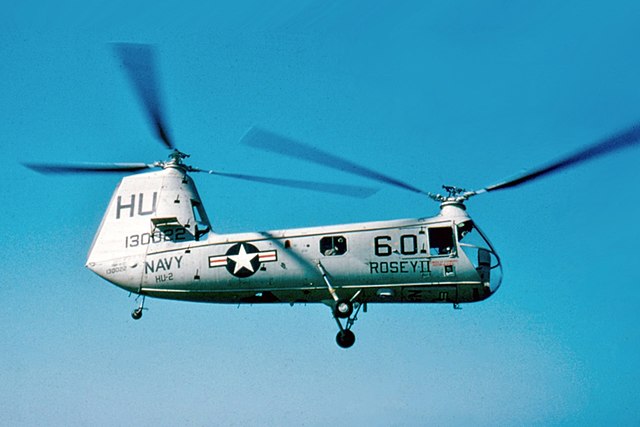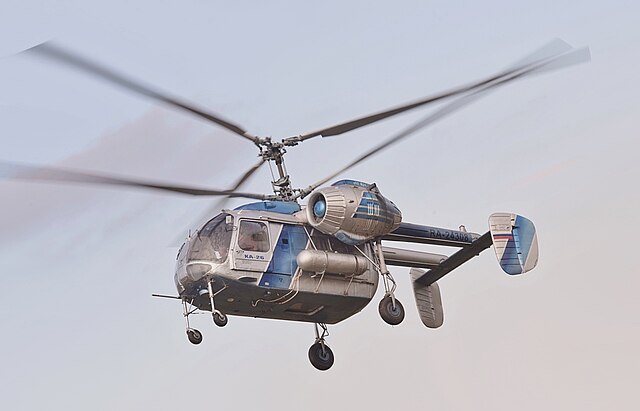User:Colin Douglas Howell/Medium piston helicopters
Medium-sized utility and transport helicopters powered by piston engines. These helicopters ranged from around 5,000 to 8,000 pounds in maximum takeoff weight and could seat anywhere from two to twelve occupants, depending on their size and their optimization toward the transport role. Power in most of these was a single air-cooled radial engine of around 450 to 700 horsepower, except for the Kamov Ka-26, which had two smaller 325-horsepower radials. The most numerous examples of this class were the Mil Mi-1, the Sikorsky H-19, and the Kamov Ka-26.
All early medium-sized helicopters were of this type until the later 1950s, when they began to be replaced by turboshaft designs. Such piston-engined helicopters were mostly obsolete by the 1970s. (The Kamov Ka-26 is a notable exception to this, being introduced at the end of the 1960s.)
These helicopters have a variety of configurations, including tandem-seating helicopters like the Sikorsky R-5/H-5, tandem-rotor machines like Piasecki's HRP and HUP, Kaman's intermeshing-rotored H-43, and the Kamov Ka-26, with its coaxial rotors, twin piston engines, and removable "box" payload module. One particularly successful configuration was the Sikorsky H-19, with conventional rotors but a nose-mounted engine. This left plenty of internal space for payload, solving the weight and balance problem which varying loads had previously posed and turning the helicopter into a practical transport. It would later be replicated in larger form in the Sikorsky H-34 and Mil Mi-4.

American two to three-seat utility helicopter, used by the U.S. Army Air Forces, Air Force, Navy, and Coast Guard.
- Produced: 1944–1946
- Number built: 65
- Capacity: 3
- Maximum takeoff weight: 5,100 lb (2,300 kg)
- Engine: Pratt & Whitney R-985-AN-5 Wasp Junior 9-cylinder radial, 450 hp (340 kW)
- Maximum speed: 106 mph (171 km/h, 92 kn)
- Range: 275 mi (443 km, 239 nmi)
- Service ceiling: 14,800 ft (4,500 m)

American four-seat utility helicopter, used by the U.S. military and other militaries as well as civil operators. Also built in Britain by Westland under license as the Dragonfly.
- Produced: 1946–1951
- Number built: 379 (220 by Sikorsky, 159 by Westland under license)
- Capacity: 4
- Maximum takeoff weight: 5,500 lb (2,495 kg)
- Engine: Pratt & Whitney R-985 Wasp Junior 9-cylinder radial, 450 hp (340 kW)
- Maximum speed: 106 mph (171 km/h, 92 kn)
- Range: 275 mi (443 km, 239 nmi)
- Service ceiling: 14,800 ft (4,500 m)

British four to five-seat utility helicopter, used by British and other military and civil operators.
- Produced: 1947–1959
- Number built: 180
- Capacity: 5
- Gross weight: 5,600 lb (2,540 kg)
- Engine: Alvis Leonides Mark 173 9-cylinder radial, 550 hp (410 kW)
- Maximum speed: 132 mph (212 km/h, 115 kn)
- Range: 330 mi (531 km, 290 nmi)

American ten-seat tandem-rotor transport/rescue helicopter, used by the U.S. Navy, Marines, and Coast Guard. Sometimes nicknamed "The Flying Banana" for its unique shape.
- Produced: 1947–1949
- Number built: 28
- Capacity: 10
- Gross weight: 7,225 lb (3,277 kg)
- Engine: Pratt & Whitney R-1340-AN-1 Wasp 9-cylinder radial, 600 hp (447 kW)
- Maximum speed: 105 mph (169 km/h, 91 kn)
- Range: 300 mi (483 km, 260 nmi)
- Service ceiling: 8,530 ft (2,600 m)

American six-seat tandem-rotor utility helicopter, used by the U.S. Navy and other military operators.
- Produced: 1949–1954
- Number built: 339
- Capacity: 6
- Maximum takeoff weight: 6,100 lb (2,767 kg)
- Engine: Continental R-975-46A 9-cylinder radial, 550 hp (410 kW)
- Maximum speed: 105 mph (169 km/h, 91 kn)
- Range: 340 mi (550 km, 300 nmi)
- Service ceiling: 10,000 ft (3,000 m)

Soviet three to four-seat utility helicopter, used by Soviet and affiliated military and civil operators. Also built in Poland by PZL under license as the SM-1.
- Produced: 1950–1965
- Number built: over 2,600 (over 1,000 by Mil, 1,594 by PZL under license)
- Capacity: 3
- Maximum takeoff weight: 5,137 lb (2,330 kg)
- Engine: Ivchenko AI-26V 7-cylinder radial, 575 hp (429 kW)
- Maximum speed: 115 mph (185 km/h, 100 kn)
- Range: 270 mi (430 km, 230 nmi)
- Service ceiling: 11,500 ft (3,500 m)

Polish five-seat utility helicopter derived from Mil Mi-1, used by Polish and other military operators.
- Produced: 1960–1963
- Number built: 86 + 3 prototypes
- Capacity: 5
- Maximum takeoff weight: 5,536 lb (2,511 kg)
- Engine: Lit-3 (licensed Ivchenko AI-26V) 7-cylinder radial, 575 hp (429 kW)
- Maximum speed: 110 mph (170 km/h, 92 kn)
- Range: 190 mi (310 km, 170 nmi)
- Service ceiling: 13,000 ft (4,000 m)

American twelve-seat utility/transport helicopter, used by the U.S. military and other militaries as well as civil operators. Also built under license by Westland in Britain (as the Whirlwind), SNCASE in France, and Mitsubishi in Japan.
- Introduced: 1950
- Number built: 1,728 (1,281 by Sikorsky, 447 by Westland and other licensees)
- Capacity: 12
- Gross weight: 7,900 lb (3,600 kg)
- Engine: Wright R-1300-3 Cyclone 7 7-cylinder radial, 700 hp (520 kW)
- Maximum speed: 112 mph (180 km/h, 97 kn)
- Range: 385 mi (620 km, 335 nmi)
- Service ceiling: 12,500 ft (3,800 m)

American four to five-seat utility helicopter with twin intermeshing contra-rotating main rotors. Used by the U.S. Air Force, Marines, and Navy and other military operators, largely for search and rescue and firefighting. Only the early versions listed here had a piston engine; later ones had a turboshaft engine. (The much lighter HTK-1/TH-43E trainer version had a 240 hp Lycoming O-435 flat-6.)
- Introduced: 1953
- Number built: about 150 with piston engines
- Capacity: 5
- Maximum takeoff weight: 6,350 lb (2,880 kg)
- Engine: Pratt & Whitney R-1340-52 Wasp 9-cylinder radial, 600 hp (447 kW)
- Maximum speed: 102 mph (165 km/h, 89 kn)
- Range: 201 mi (324 km, 175 nmi)
- Service ceiling: 15,300 ft (4,660 m)

Soviet two to eight-seat utility helicopter used by some Warsaw Pact and affiliated military and civil operators. Has twin radial engines in outboard nacelles, along with the usual Kamov layout of twin coaxial counter-rotating main rotors, twin tail fins and rudders, and no tail rotor. The payload is carried in a removable "box" module, with different versions for different applications.
- Produced: 1968-1985
- Number built: 816
- Capacity: 8 (with passenger module)
- Maximum takeoff weight: 7,165 lb (3,250 kg)
- Engines: two Vedeneyev M-14V-26 9-cylinder radials, 325 hp (243 kW) each
- Maximum speed: 110 mph (170 km/h, 92 kn)
- Range: 250 mi (400 km, 220 nmi) with 7 passengers, 30-minute reserve
- Service ceiling: 9,800 ft (3,000 m)